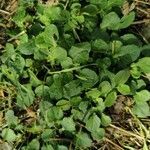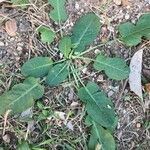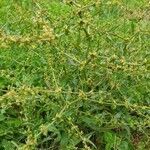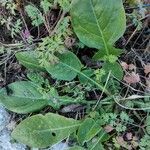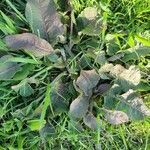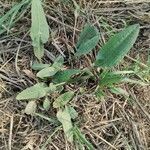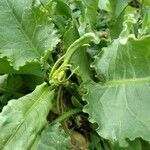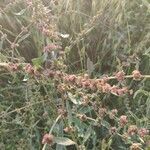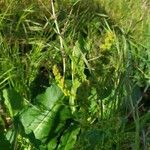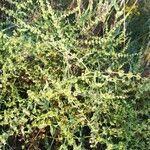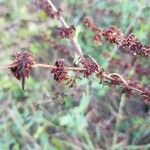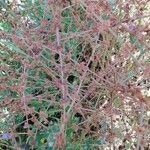Perennial herb; taproot thick; stems many, spreading, to c. 60 cm tall. Petiole of lower lvs long and often > lamina, often puberulent. Lamina of lower lvs 3-20 × 1-8 cm, with basal 1/4 of lamina forming 2 large rounded cordate lobes with a rounded sinus at the junction with remainder of lamina and thus lf constricted in basal 1/2, flat, occasionally simple, oblong, puberulent towards base beneath; apex obtuse to rounded. Upper cauline lvs much smaller, simple, oblong, entire, with cuneate base. Infl. branches spreading at a wide angle at flowering, later becoming twisted and forming a tangled mass. Whorls of fls distant; subtending lvs present to the branch apex, reduced, narrow-linear, < 1 cm long; pedicels slender, ciliolate. Fls ☿, strongly protandrous. Perianth 1-2 mm long, often reddish; segments of outer whorl ± ovate-oblong, not reflexed at fruiting; segments of inner whorl becoming much elongated. Fr. valves 4.5-5.5 mm long, triangular, often narrowly so, with thick, raised reticulations; apex obtuse; marginal spines to 2 mm long, thick; tubercles unequal but prominent on each valve, oblong. Nut 1.8-3 mm long, deep shining brown, acutely angled.
Perennial herb, up to 0.6 m long; stems ± angular-flexuose, branching from below middle. Leaves ovate-oblong, base cordate, apex acute, margins ± subdenticulate; petioles shorter than lamina; upper cauline leaves few, smaller. Inflorescences branched, angularly reflexed or arcuate-divaricate. Flowers in many-flowered whorls, nearly all subtended by a leaf, uppermost whorls leafless; greenish; inner perianth segments toothed. Flowering time Aug.-Apr. Fruiting pedicels ± as long as valves. Fruiting valves leathery, narrowly or broadly ovate, apex ligulate or broadly acuminate, reticulation foveolate, margins grossly dentate, pale brown; callosity basal on main vein of each valve, fusiform, > 1/2 as long as wings, apex long attenuate. Fruit a nut, up to 4 mm long.
Slender, branching perennial 2–8 dm from a taproot; lvs basally disposed, the lower commonly constricted just above the cordate base, hairy on the petiole and veins beneath; infl very large, with many divergent spike-like branches, the glomerules separate, mostly subtended by reduced lvs; pedicels stout, conspicuously jointed, about as long as the fr; valves triangular-ovate, 4–5 mm, conspicuously reticulate, each with 2–6 spinose teeth on each margin below the middle; fully developed grain 1, verrucose, the other valves bearing imperfect small grains; 2n=20. Native of Europe, intr. in waste places from N.Y. to Fla., Okla., and Tex., and on the Pacific coast.
An erect herb. It grows about 60 cm high. It has stiff spreading branches. The leaves have a soft texture. They are 3-13 cm long by 10-30 mm wide. They are oblong to heart shaped and often with a narrow waste just below the middle. The flowering stalk has angular branches. It droops and forms tangled masses. The fruit have projections which are not hooked.
